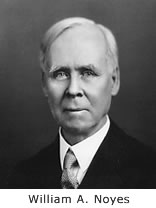William A. Noyes
| William Albert Noyes | |
|---|---|
 |
|
| Born | November 6, 1857 near Independence, Iowa |
| Died | October 24, 1941 (aged 83) |
| Citizenship | United States |
| Fields | Chemistry |
| Institutions | University of Illinois |
| Alma mater | Johns Hopkins University |
| Doctoral advisor | Ira Remsen |
| Doctoral students | Carl Shipp Marvel |
| Known for | Camphor chemistry |
| Notable awards | Willard Gibbs Award (1919) |
William Albert Noyes (November 6, 1857 – October 24, 1941) was an American analytical and organic chemist. He made pioneering determinations of atomic weights, chaired the Chemistry Department at the University of Illinois at Urbana-Champaign from 1907 to 1926, was the founder and editor of several important chemical journals, and received the American Chemical Society's highest award, the Priestley Medal, in 1935.
Noyes was born on November 6, 1857 near Independence, Iowa. He earned A.B. and B.S. degrees from Grinnell College in 1879 (having originally enrolled in 1875 in classical studies, with chemistry as a side subject). As an undergraduate, in the winter quarters Noyes taught school full-time in the countryside. On graduating he studied and taught analytical chemistry at Grinnell, until he began graduate school at Johns Hopkins University in January 1881. There, working with Ira Remsen, Noyes earned his Ph.D. in 1882. His doctoral dissertation "On the oxidation of benzene with chromic acid" was completed in only one and a half years (despite his also having to do water analyses to earn a living). Grinnell also awarded him an A.M. degree for this work.
After receiving his doctorate, Noyes taught a year as an instructor at the University of Minnesota. He was next a professor of chemistry at the University of Tennessee, followed by seventeen years at Rose Polytechnic Institute in Terre Haute, Indiana (starting there in 1886). In 1903, Noyes was hired as the first "Chief Chemist" for the United States National Bureau of Standards in Baltimore, Maryland. His determination of atomic weights lead to "one of the most precise chemical determinations ever made", the ratio of the masses of hydrogen to oxygen (which he found to be 1.00787:16). With H.C.P. Weber, he received the Nichols Medal (chemistry) in 1908 for determining the atomic weight of chlorine.
...
Wikipedia
